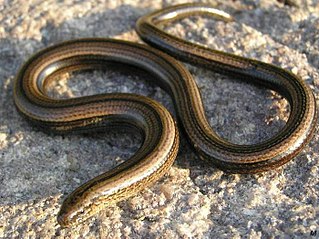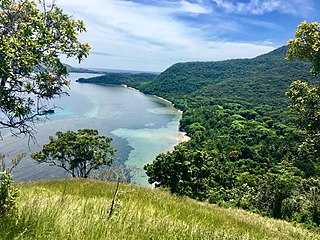
Flores is one of the Lesser Sunda Islands, a group of islands in the eastern half of Indonesia. Administratively, it forms the largest island in the East Nusa Tenggara Province. Including Komodo and Rinca islands off its west coast, the land area is 14,731.67 km2, and the population was 1,878,875 in the 2020 Census ; the official estimate as of mid-2023 was 1,962,405. The largest towns are Maumere and Ende. The name Flores is of Portuguese origin, meaning "Flowers".

The Komodo dragon, also known as the Komodo monitor, is a large reptile of the monitor lizard family Varanidae that is endemic to the Indonesian islands of Komodo, Rinca, Flores, Gili Dasami, and Gili Motang. It is the largest extant species of lizard, with the males growing to a maximum length of 3 m (9.8 ft) and weighing up to 150 kg (330 lb).

Komodo National Park is a national park in Indonesia located within the Lesser Sunda Islands in the border region between the provinces of East Nusa Tenggara and West Nusa Tenggara. The park includes the three larger islands Komodo, Padar and Rinca, and 26 smaller ones, with a total area of 1,733 km2. The national park was founded in 1980 to protect the Komodo dragon, the world's largest lizard. Later it was dedicated to protecting other species, including marine species. In 1991 the national park was declared a UNESCO World Heritage Site and a Man and Biosphere Reserve. It is considered one of the world's 25 biodiversity hotspots.

Komodo is one of the 17,508 islands that comprise the Republic of Indonesia. It is particularly notable as the habitat of the Komodo dragon, the largest lizard on Earth, which is named after the island. Komodo Island has a surface area of 291 square kilometres, and had a human population of about 1,800 in 2020.

Rinca is a small island near Komodo and Flores island, East Nusa Tenggara, Indonesia, within the West Manggarai Regency. It is one of the three largest islands included in Komodo National Park. The island is famous for Komodo dragons, giant lizards that can measure up to 3 metres (9.8 ft) long. Rinca is also populated with many other species such as wild pigs, buffalos and many birds.

Psammodynastes pulverulentus, the common mock viper, is a species of snake native to Asia.

Polillo is an island in the northeastern region of the Philippine archipelago. It is the largest island and the namesake of the Polillo Islands. It is separated from Luzon Island by the Polillo Strait and forms the northern side of Lamon Bay.

The Sape Strait or Sapie Strait is a strait connecting the Flores Sea to the Sumba Strait. It separates the islands of Sumbawa and Komodo. It joins the Indonesian provinces of West Nusa Tenggara and East Nusa Tenggara.

The Anguimorpha is a suborder of squamates. The group was named by Fürbringer in 1900 to include all autarchoglossans closer to Varanus and Anguis than Scincus. These lizards, along with iguanians and snakes, constitute the proposed "venom clade" Toxicofera of all venomous reptiles.

Trimeresurus insularis or Indonesian pit viper, Lesser Sunda Islands pit viper, Sunda white-lipped pit viper, red-tailed pit viper is a venomous pit viper species found in eastern Java and the Lesser Sunda Islands, Indonesia.

West Manggarai Regency is one of the eight regencies which comprise the island of Flores, located in the province of East Nusa Tenggara in Indonesia. The Regency was created on 25 February 2003 by the separation off of the western districts from Manggarai Regency. It covers a land area of 3,141.47 km2, and had a population of 221,703 at the 2010 census, rising to 251,689 at the 2015 Intermediate census and to 256,317 at the 2020 census. The official estimate as at mid 2023 was 278,184. The regency's capital is the town of Labuan Bajo.

The Lesser Sundas deciduous forests is a tropical dry forest ecoregion in Indonesia. The ecoregion includes the islands of Lombok, Sumbawa, Komodo, Flores, and Alor, along with the many adjacent smaller islands.

Labuan Bajo is a fishing town located at the western end of the large island of Flores in the East Nusa Tenggara province of Indonesia. It is in Komodo District. It is the capital of the West Manggarai Regency, one of the eight regencies on Flores Island.

The banded pig also known as the Indonesian wild boar is a subspecies of wild boar native to the Thai-Malay Peninsula and many Indonesian islands, including Sumatra, Java, and has been introduced to the Lesser Sundas in ancient times. It is known as the wild boar in Singapore. It is the most basal subspecies, having the smallest relative brain size, more primitive dentition, and unspecialised cranial structure. It is a short-faced subspecies with a white band on the muzzle, as well as sparse body hair, no underwool, a fairly long mane, and a broad reddish band extending from the muzzle to the sides of the neck. It is much smaller than the mainland S. s. cristatus subspecies, with the largest specimens on Komodo weighing only 48 kg.

The Lesser Sunda Islands, now known as Nusa Tenggara Islands, are an archipelago in Indonesian archipelago. Most of the Lesser Sunda Islands are located within the Wallacea region, except for the Bali province which is west of the Wallace Line and is within the Sunda Shelf. Together with the Greater Sunda Islands to the west, they make up the Sunda Islands. The islands are part of a volcanic arc, the Sunda Arc, formed by subduction along the Sunda Trench in the Java Sea. In 1930 the population was 3,460,059; today slightly over 15.5 million people live on the islands. Etymologically, Nusa Tenggara means "Southeast Islands" from the words of nusa which means 'island' from Old Javanese language and tenggara means 'southeast'.
The Komodo Biosphere Reserve and National Park is situated between Flores and Sumbawa in Indonesia. It is renowned for its population of about 5,000 giant lizards, called 'Komodo dragons'. They exist nowhere else in the world and are of significant interest to scientists studying the theory of evolution.

Komodo Indonesian Fauna Museum and Reptile Park, is a zoological museum located within the Taman Mini Indonesia Indah (TMII) compound, in East Jakarta, Indonesia. The museum specialized on presenting various collection of the fauna of Indonesia, especially endemic animals of Indonesia, to provides information and education on Indonesian animal diversity. The Komodo Fauna Museum is located on southeast corner of Taman Mini Indonesia Indah cultural park.

The Kokotuku Peninsula is a 986 hectare tropical land mass located 20 kilometers north of the city of Labuan Bajo, West Manggarai, Flores NTT, Indonesia. The West Flores-Komodo region is a UNESCO World Heritage Site, and is considered one of the Seven Wonders of the Natural World.




















